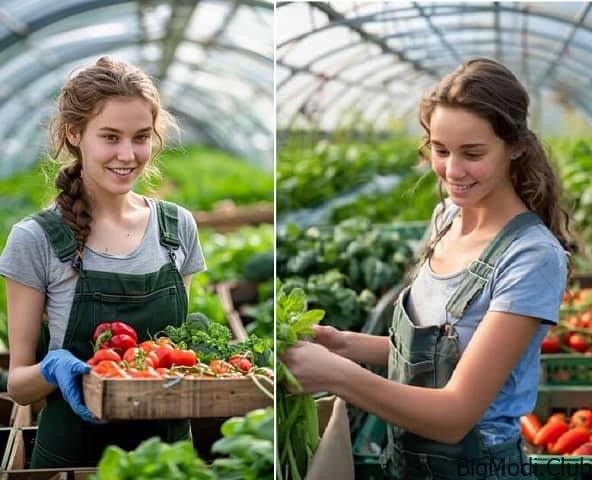Harvesting tomatoes (Tomato Harvest) is a critical step in gardening that demands attention to detail and timing. When it comes to the harvest tomato process, knowing the right moment to pick and the best methods to use can significantly impact the quality of your produce. This guide delves into the intricacies of tomato harvesting, covering everything from the ideal harvest times for various tomato types to the techniques for handling green tomatoes. Whether you’re dealing with ripe fruit or need to salvage green tomatoes, understanding these key aspects will help you achieve the best results from your garden.
Harvesting Tomatoes: A Complete Guide
Days to Harvest
Tomato Harvest varieties differ in their time to maturity. Early varieties are ready to harvest in less than 70 days, mid-season types ripen between 70 and 80 days, while late-season varieties need more than 80 days to fully mature. Each variety offers unique flavors and qualities, so it’s essential to choose one that fits your growing season.
When to Harvest
The timing of your tomato harvest largely depends on your growing region. For example:
- California and Pacific Northwest: Tomatoes ripen from late spring and continue through the summer.
- Mid-Atlantic: The best season is late spring to early summer.
- Northeast and Midwest: Tomatoes ripen from July until the first frost of fall.
- South and Southwest: Harvest ends early, often by June, due to extreme heat.
By understanding your region’s climate, you can anticipate the best time to gather your tomatoes before weather conditions like frost or heat affect your crop.
Methods of Harvesting
There are two primary methods for harvesting tomatoes:
- Manual Harvesting: Ideal for tomatoes that will be eaten fresh or canned whole. This method ensures you can pick the fruit gently, minimizing damage.
- Mechanical Harvesting: Often used for tomatoes destined for sauces and concentrates. Machines harvest the plants, separating the fruit from the plant matter quickly and efficiently.
Both methods have their advantages, but manual harvesting is generally preferred for home gardeners aiming for fresh, quality tomatoes.
Growing Time
On average, tomatoes are ready to harvest 60 to 100 days after transplanting the seedlings. If starting from seeds, the timeline extends to 100 to 120 days. Some fast-growing varieties, such as cherry tomatoes, can be harvested in as little as 50 days after transplanting.
Cherry Tomato Harvest
Tomato Harvest: Cherry tomatoes are a popular choice for home gardens due to their quick ripening and flavorful taste. Typically, cherry tomatoes are ready for harvest between 50 and 65 days after planting.
- Color Changes: Depending on the variety, ripe cherry tomatoes will turn red, orange, yellow, or even purple. When the fruit easily detaches from the stem, it’s time to harvest.
- Frequent Harvesting: To prevent overripening, it’s essential to check your cherry tomato plants every couple of days. Overripe fruits can split, fall off the plant, or rot on the vine.
Examples of different cherry tomato varieties include ‘Sun Gold,’ which ripens into a bright orange color, and ‘Midnight Snack,’ which turns a deep purple when ready for harvest.
Caring for the Harvest
To ensure a healthy and consistent tomato harvest, regular care is crucial. Providing sufficient water and fertilizer, especially during periods of extreme heat or drought, can prevent issues like fruit splitting or blossom-end rot. This attention to plant health not only ensures a good harvest but also maintains the quality of your tomatoes throughout the growing season.
Harvesting and Ripening Green Tomatoes
Sometimes, tomato plants don’t cooperate with our ripening timelines. When tomatoes refuse to turn red on the vine, don’t worry—you can pick those unripened green tomatoes and still enjoy their flavor later on. Here’s how to make the most of your green harvest.
How to Identify Green Tomatoes Ready for Harvest
Not all green tomatoes are created equal. To ensure the best results, you’ll want to pick nearly-ripe, mature green tomatoes. What do they look like? Look for tomatoes with a glossy, whitish-green hue, or those with a slight blush of pink. Larger tomatoes tend to ripen better indoors, so size matters here.
Also, make sure the vines themselves are in good health. Only pick from plants that are free from disease, pests, or mechanical damage. A healthy vine means healthier tomatoes!
Preparing Green Tomatoes for Storage
Once you’ve picked your green tomatoes, it’s time to get them ready for storage. First, remove the stems. Why? This prevents the tomatoes from poking and damaging one another during storage. After removing the stems, give the tomatoes a gentle wash to remove any dirt. For an extra layer of protection, you can use a mild bleach solution (1 teaspoon bleach to 1 quart of water) to kill off any bacteria that could cause the fruit to spoil before ripening.
Let the tomatoes air dry completely before storing them.
Ripening Green Tomatoes Indoors
Now that your tomatoes are prepped, you can ripen them indoors. To do this effectively, you’ll want to sort the tomatoes by their ripeness. Group together tomatoes that are at similar stages to ensure even ripening.
Take a cardboard box and line it with newspaper. Place a layer of tomatoes inside, making sure they don’t touch each other. Add another layer of newspaper on top, and then another layer of tomatoes if needed. Store this box in a moderately humid room, keeping the temperature between 55°F and 70°F.
The ripening time will vary depending on the temperature. At 65°F to 70°F, expect the tomatoes to ripen within two weeks. Cooler temperatures between 55°F and 60°F will slow the process, with ripening taking three to four weeks.
To ensure the best results, keep the box out of direct sunlight. Check on your tomatoes every week. Remove any that have ripened and discard any that have started to spoil.
FAQs
When should you harvest tomatoes?
Tomatoes should be harvested when they reach their mature color, which can be red, yellow, orange, or even purple depending on the variety. During the Tomato Harvest, they should be firm but give slightly under pressure. For most varieties, harvest time is typically in late spring through summer, although it can vary based on the region. In cooler climates, tomatoes ripen from July until the first fall frost. In hotter regions, like the South, harvesting may end by early June due to heat.
How long do tomatoes take to harvest?
The time it takes for tomatoes to be ready for harvest depends on the variety:
- Early varieties can be harvested in less than 70 days.
- Mid-season varieties take between 70 and 80 days.
- Late-season varieties need over 80 days to mature.
Cherry tomatoes generally ripen faster, typically 50 to 65 days after planting.
What are the 5 stages of tomato harvesting?
- Green Stage: Tomatoes are still green but have reached full size.
- Breaker Stage: The first signs of color appear—yellow, orange, or pink hues.
- Turning Stage: About 30% to 60% of the tomato has changed color.
- Pink/Red Stage: The tomato is almost fully ripened, showing 90% or more of its mature color.
- Fully Ripened Stage: The tomato is fully colored and softens slightly, ready to be picked.
How to use tomato harvest?
There are several ways to make the most of your tomato harvest:
- Fresh Use: Enjoy ripe tomatoes in salads, sandwiches, or sauces.
- Canning and Preserving: Preserve your tomatoes by making sauces, salsas, or tomato paste for future use.
- Indoor Ripening: If tomatoes are still green, you can ripen them indoors by storing them in a cool, dry place with proper ventilation.
- Cooking with Green Tomatoes: If you prefer, green tomatoes can be cooked into dishes like fried green tomatoes or green tomato relish.


